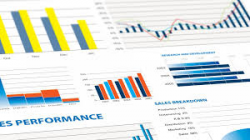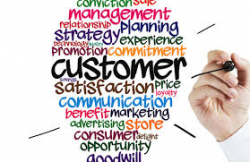How Manufacturers Are Capitalizing On Sales Metrics & KPIs
 In today’s dynamic business environment, a well-designed sales analytics program can easily become a competitive advantage for manufacturers by allowing them to quickly adapt to changing market conditions, trends and customer demands.
In today’s dynamic business environment, a well-designed sales analytics program can easily become a competitive advantage for manufacturers by allowing them to quickly adapt to changing market conditions, trends and customer demands.
Sales metrics and key performance indicators (KPIs) empower a salesperson, team or organization to assess performance against goals and objectives, monitor progress and make necessary adjustments for continued sales success. They can also help businesses identify opportunities, pinpoint and resolve potential issues (like at-risk customers), and ensure a continued focus on their sales strategies.
When the right sales metrics are in place, an organization can produce more accurate demand planning outcomes and gain the insights needed to better understand where they stand from a sales perspective by customer, territory, and as a company overall. Appropriate sales metrics also help identify the state of sales regarding time-based goals. Perhaps most importantly, the right sales metrics can help an organization make the right decisions necessary to achieve both their short- and long-term objectives.
But what are the right sales goals? And what are the most important sales KPIs?
The Basics of Sales KPIs
Sales KPIs are metrics that help you monitor and make decisions about your sales strategies and initiatives. In an effective KPI strategy, I always suggest to our manufacturing and wholesale distribution clients that they keep the following basic principles in mind.
- Every sales KPI needs a clearly defined goal. This goal needs to be something that can be numerically defined (quantitative not qualitative) and attainable in a reasonably finite period of time.
- It is very important that you are able to objectively measure your progress toward the goal by collecting and interpreting data.
- There must be a clearly defined data source with a standardized process for collecting and measuring that data. To accomplish this, our clients rely on the built-in data hub of our Stratum reporting application. The Stratum data hub collects, organizes and stores data from multiple sources and serves as a single version of the truth for helping our clients analyze performance KPIs and metrics across their businesses. Plus, Stratum’s packaged sales analytics (along with analytics that span other areas of their organizations) enable our clients to effectively report on and visualize both their manufacturing-centric and enterprise-focused KPIs.
Download Silvon’s Definitive Guide to KPIs:
Concepts, Best Practices & More
While sales KPIs should be chosen based on your organization’s specific needs, certain ones are effective for most businesses. Here are some key areas to analyze and some commonly applicable sales KPIs that Silvon has used with its clients to help them drive better sales performance.
Predictive Demand Planning & Forecasting
A key benefit of tracking sales metrics is the ability to predict future sales based on historical data. Historical sales data gives you an accurate and realistic picture of how much revenue your team should be generating within a certain time period. When you can accurately forecast what revenue will be and spot risks early, you can use that knowledge not only to better allocate and manage resources, but to be more agile in responding to changing market conditions, too.
Revenue & Profit Contributions
- Revenue From New Customers
Account managers and those in field sales covering various territories usually generate additional revenue from current customers; but for this sales-related KPI, the value of a contract or order is calculated instead as new revenue every time a new client is landed. It’s a great KPI to monitor and use in future sales plans and forecasts. - Revenue From Current Customers
Metrics that are defined to analyze revenue from current customers can be utilized to ensure that a contract renews or that upselling and cross-selling techniques are deployed to increase revenue numbers from the current base. This KPI can also play a key role in sales planning and forecasting. - Year-over-Year (YoY) Growth
Year-over-year comparisons are usually generated when targets and KPIs are being set. YoY growth is an important metric because it helps sales organizations account for fluctuations in seasonality and other factors when analyzing performance. - Average Profit Margin
Average profit margin is an important financial KPI because it measures how much of overall sales revenue results in profits. Companies can also analyze profit margins generated by specific products, sales territories and salespeople.
Sales / Bookings Performance
- Monthly Sales Growth
By tracking monthly sales growth, leaders can quickly spot problems and act on trends. Establishing realistic sales growth targets based on this information can also ensure consistent alignment of a sales team’s efforts with the organization’s expectations. - Monthly Sales Bookings
Sales bookings calculate the value of committed or won sales over a specific period. Sales teams often use monthly sales bookings to track the value of their wins. Leaders also use this metric to develop sales strategies and forecasts. - Average Purchase Value
Average purchase value reflects the average amount each customer spends on a business’s products or services. Sales leaders use the average purchase value metric to develop sales strategies that incent customers to spend more and to forecast the value of leads. - Discounts Applied per Sale
Discounts applied per sale (or percent of sales discounts) take++ into account the price decrease of a product after any promotion. Discounts benefit the buyer and have the potential to increase short-term sales. This KPI helps sales organizations understand which discounts are most effective and which can help reach sales objectives faster by attracting prospects with incentives that work. - Average Cost or Price per Unit
Average price per unit measures the marketing costs your company spent on a single product purchase. While this metric varies by industry and product type, it is generally used to measure the effectiveness of sales and marketing campaigns and promotions.
Download Silvon’s KPI Guide – Drive Better Business Performance
Customer Performance Metrics
- Customer Lifetime Value
Customer lifetime value refers to how much a company expects to earn over the entire time it conducts business with a customer. Businesses use this important metric to determine which customer segments generate the most revenue and how much to spend to acquire new customers. The calculation for customer lifetime value related to a company’s entire base involves several components, including gross margin, churn, average customer spend, etc. Of course, this metric could apply to individual customers as well for better account-based management. - Customer Churn & Retention Rates
Many companies use historical customer sales data to identify retention and churn rates. Retention rate is a critical sales metric that reflects a sales team’s ability to retain customers and generate recurring revenue. On the flip side, churn rate represents the percentage of customers who cancel or don’t renew their sales orders or contracts. This KPI is a critical one for most businesses because it is generally more cost-effective to retain existing customers than to find new ones. - Customer Acquisition Cost
The cost to acquire a customer depends on an organization’s business model, but factoring in all sales and marketing expenses, including salaries and overhead, can ensure a comprehensive calculation. Using this metric to cut future costs related to bringing a new customer onboard can be invaluable to helping your organization maintain or increase its profitability. - Upsell and Cross-Sell Rates
Upsell and cross-sell metrics track when, how, and to what type of customer your sales reps are upselling and cross-selling. Keeping track of upsell and cross-sell initiatives can reveal needs that similar customers may have and products that are displaying poorer performance. - RFM (Recency, Frequency & Monetary value)
RFM metrics are important indicators of a customer’s behavior because Frequency and Monetary value affects a customer’s lifetime value, while Recency affects retention – a measure of engagement. RFM analysis helps businesses determine who their best customers are, which customers could churn, which have the potential to become valuable and which are most likely to respond to engagement campaigns. - Customer Service
Customer service metrics provide the visibility you need to see how well you are servicing and managing your customers. Among others, these metrics include the analysis of customer returns, order fill rates, shipment rates, backorder rates, problem severity rankings, CSR performance and the impact of customer issues on sales.
Product Performance Factors
Product sales volume doesn’t always correlate with revenue performance. For example, low-price but high-volume products may account for a large portion of total sales but may not rank in your top 10 list of revenue-generating products. As with most sales metrics it’s important to consider other factors surrounding your products. For example, is a product experiencing a sales boost due to an extensive marketing campaign? Or did product sales decrease because of a competitor’s lower-priced offering? Sales leaders can use product sales metrics to evaluate market trends and adjust their sales plans accordingly.
While not all-inclusive, I hope this list sparks some ideas for the sales KPIs and metrics that you should be using as part of a focused sales strategy. In my next posts, I’ll take a deeper dive into some of the sales KPIs mentioned above and will explore numerous other metrics and KPIs as they relate to sales activity, sales pipeline, lead generation and sales productivity.
Silvon helps mid-market manufacturing and wholesale distribution companies accelerate growth through our suite of financial and operational planning, reporting and analysis applications. See how we can help you execute your KPI strategy and all of your performance management initiatives from the C-suite to your production and distribution facilities.
Download our Free KPI Guide To Stay Focused, Aligned & Accountable



